#House Hesse-Darmstadt
Text

Princess Augusta Wilhelmina of Hesse-Darmstadt (14 April 1765 – 30 March 1796) was Duchess consort of Zweibrücken by marriage to Maximilian, Duke of Zweibrücken and the mother of King Ludwig I of Bavaria.
#Augusta Wilhelmina of Hesse-Darmstadt#House Hesse-Darmstadt#xviii century#people#portrait#paintings#art#arte
4 notes
·
View notes
Text



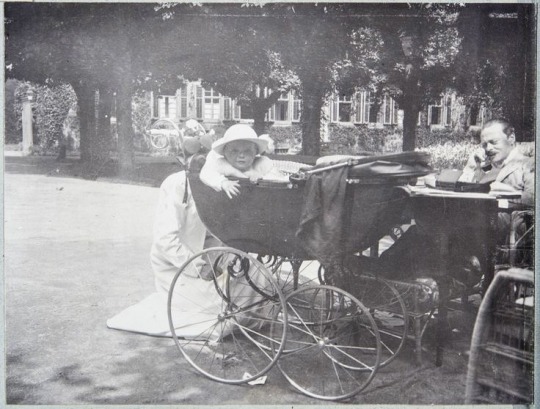
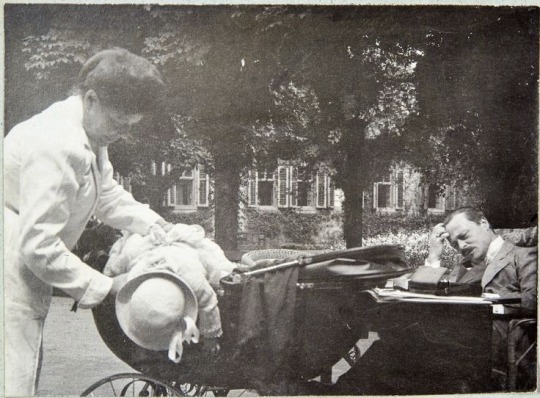


Ernst Louis and his son Georg Donatus in 1907❤️.
#Ernest Louis#georg donatus#hesse and by rhine#hessein#georg donatus of hesse#Ernst Louis of Hesse#grand duke of hesse and by rhine#hereditary grand duke of hesse and by rhine#house of hesse#hesseian royal family#darmstadt
75 notes
·
View notes
Text

Alice, Grand Duchess of Hesse (nee Princess of The United Kingdom)
11 notes
·
View notes
Text
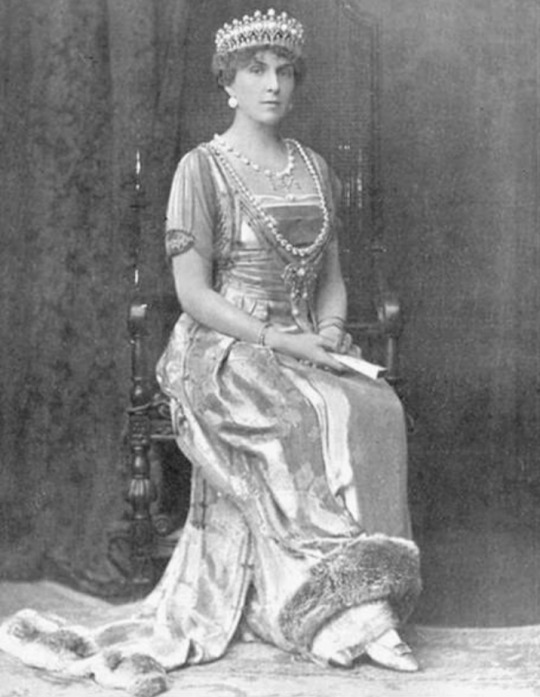
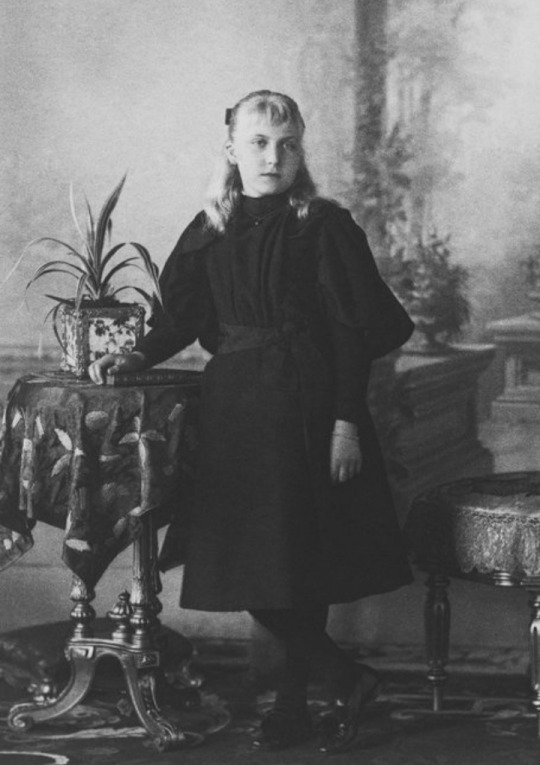
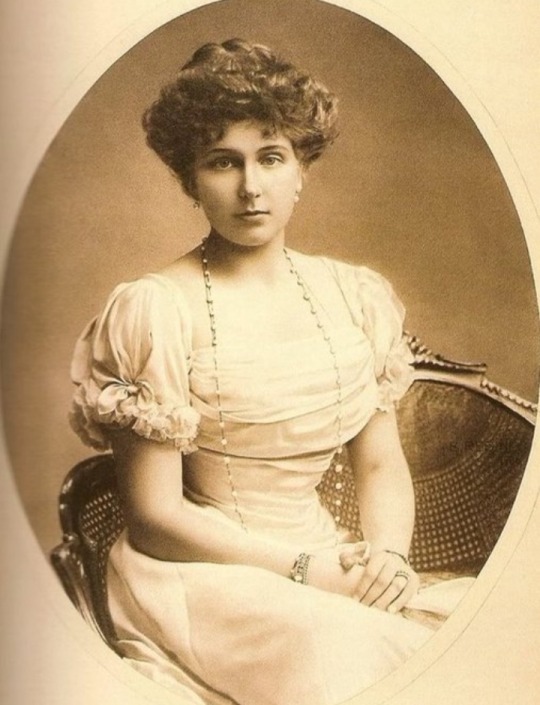
BORN ON THIS DAY:

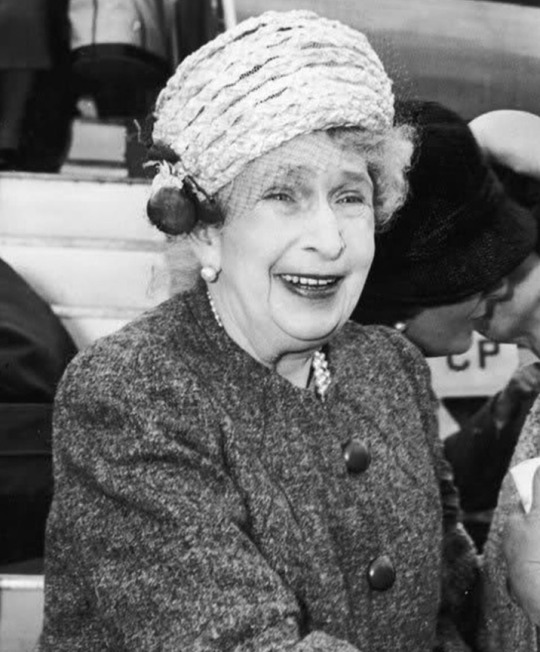
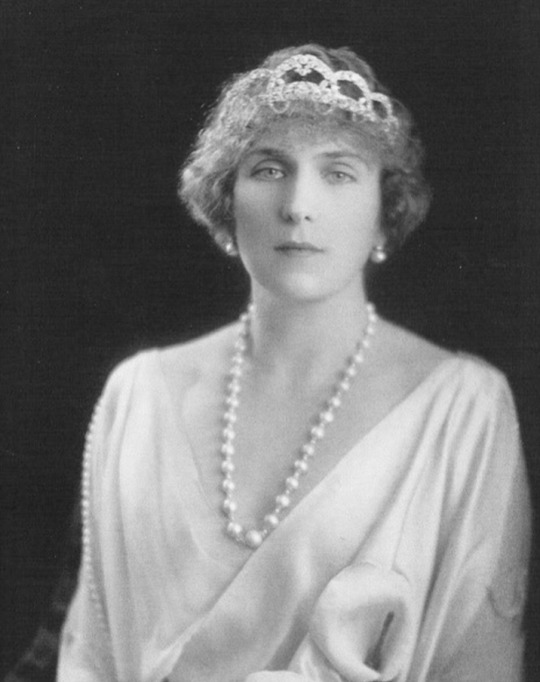


Victoria Eugenie of Battenberg (Victoria Eugenie Julia Ena; 24 October 1887 – 15 April 1969) was Queen of Spain as the wife of King Alfonso XIII from their marriage on 31 May 1906 until 14 April 1931, when the Spanish Second Republic was proclaimed.
A Hessian princess by birth, she was a member of the Battenberg family, a morganatic branch of the House of Hesse-Darmstadt.
She was the youngest granddaughter of Queen Victoria and Prince Albert.
Unlike other members of the Battenberg family who were accorded the lower rank of Serene Highness, Victoria Eugenie was born with the rank of Highness due to a Royal Warrant issued in 1886 by Queen Victoria.
#Victoria Eugenie of Battenberg#King Alfonso XIII#Spanish Second Republic#House of Hesse-Darmstadt#House of Battenberg#House of Saxe-Coburg and Gotha#House of Windsor#House of Bourbon-Anjou#House of Habsburg-Lorraine#British Royal Family#Spanish Royal Family
6 notes
·
View notes
Text
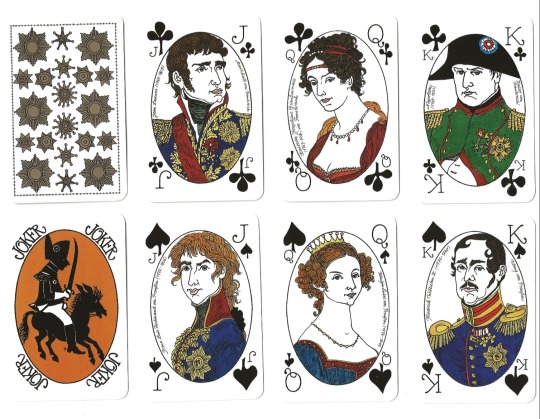

Glaux Verlag Christine Jäger [German publishing house that was based in Jena at the time these were made] Napoleonic Playing Cards
♣️: Marshal Lannes, Empress Josephine, Napoleon
♠️: Prince Louis-Ferdinand of Prussia, Queen Louise, Frederick-William III
♥️: Marshal Kutuzov, Tsarina Elizabeth-Alexeievna, Tsar Alexander I
♦️: Prince Frederick-Louis of Hohenlohe, Princess Louise of Hesse-Darmstadt, Duke Karl August Grand Duke of Saxe-Weimar-Eisenach
#they got the tsarina’s birth year wrong lol#my napoleonic playing cards#tsar alexander#napoleon bonparte#empress josephine#marshal lannes
28 notes
·
View notes
Text


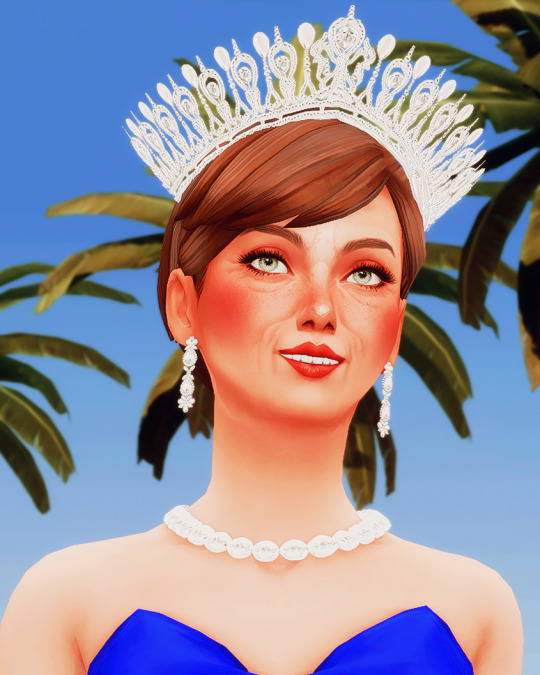
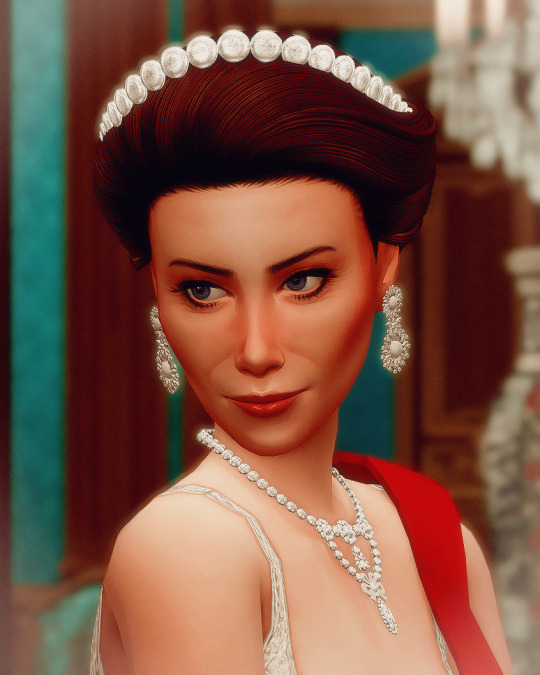

Sunderland's Royal Jewel Vault (10/∞) ♛
↬ Hesse Diamond Bandeau
This necklace-turned-tiara is one of the oldest in the royal vault. It originated in 1840 as a rivière of thirty-four brilliant diamonds. The diamonds were one of the hundreds of gifts the sixteen-year-old Princess Marie of Hesse received on the occasion of her wedding to Tsesarevich Alexander Nikolayevich, the future Emperor Alexander II of Russia.
Marie, immortalized as Emperess Maria Alexandrovna, had a secluded upbringing in Darmstadt and found the opulence of the Imperial Russian court overwhelming, but she slowly began to identify with her adopted country over the years. Photographs depict the Empress drenched in jewels, including the diamond rivière, which she wore as a necklace.
From here, the necklace's chain of inheritance gets a little muddy. Over the decades several of Empress Maria's daughters and daughters-in-law sported the necklace, yet there is no strong evidence of who owned the jewel following the Empress's death in 1880. Among others, two of the most notable wearers were Maria's successor Empress Maria Feodorovna (née Dagmar of Denmark) and her eldest daughter Queen Alexandra of Sunderland (née Grand Duchess Alexandra Alexandrovna). It is unclear which of Maria's female descendants owned the necklace, or if they had simply borrowed it for a time.
Either way, the necklace eventually landed in the jewelry box of Queen Alexandra's daughter-in-law, Matilda Mary, and it remained in Sunderland from that point onwards. Matilda was never photographed wearing the necklace, but she eventually bequeathed the mysterious jewel to Katherine Rothman, her granddaughter-in-law, when she became Princess of Danforth in 1943. Katherine mainly opted to wear twenty-seven of the diamonds set on a tiara frame. She favoured this improvised bandeau for trips to the Royal Alexandra Opera House both during and after her tenure as Queen. As a tiara, the diamonds were practical and lightweight, better for evenings out than formal state events.
The jewel's next wearer was Katherine's daughter-in-law Phyllis, who only ever wore the piece as a necklace, often pairing it with her Garland and Déléage Tiaras. The necklace was also worn without a tiara to many film premiers in the 80s and 90s. To this day these Hessian diamonds remain a popular staple of Phyllis's jewellery collection.
#warwick.jewels#ch: katherine#ch: phyllis#ts4#ts4 story#ts4 storytelling#ts4 edit#ts4 royal legacy#ts4 legacy#ts4 royalty#ts4 monarchy#ts4 screenshots#✨
47 notes
·
View notes
Text
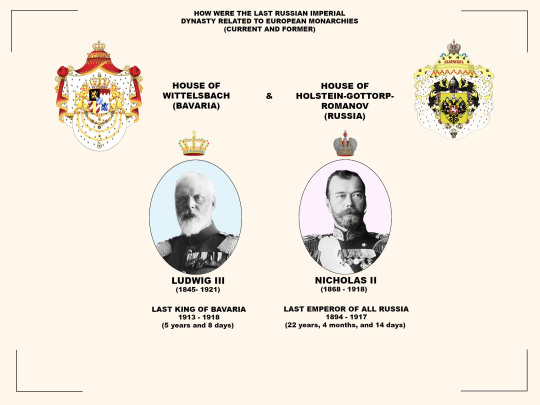


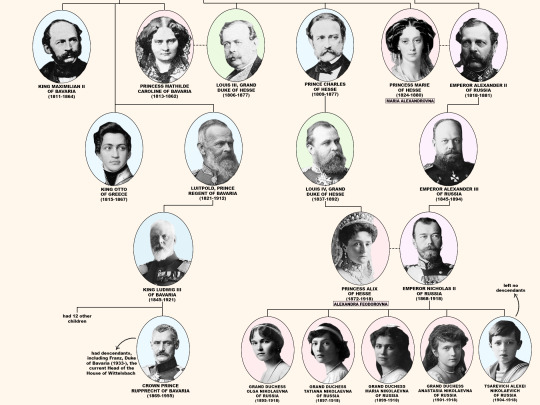
How the last Russian Dynasty were related to European Monarchies (current and former):
The House of Wittelsbach (Royal Dynasty of Bavaria) and the House of Holstein-Gottorp-Romanov (Imperial Dynasty of Russia) were distantly related, their common ancestor being Louis VIII, Landgrave of Hesse-Darmstadt.
36 notes
·
View notes
Photo
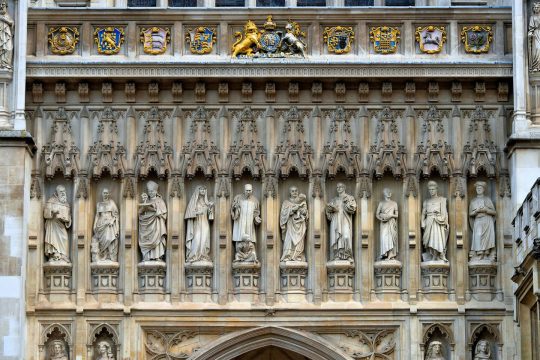

Quid est martyrium? Mortem pati pro Christo. Quid est Christianum? Christum sequi*
- St. Augustine
What is martyrdom? To suffer death for Christ. What is a Christian? To follow Christ.*
After the restoration of the western towers of the Abbey had been completed in 1995, it was decided to fill the 10 gothic niches above the west doorway with statues. The lower part of the towers date from the 15th century and the tops of the towers were completed in 1745. The niches never had statues, although this was obviously the plan of decoration.
It was decided to use the ten niches not just to commemorate saints or worthy figures from the past. So instead of traditional figures of kings or saints, the abbey decided that martyrs of the 20th century should be remembered. The West entrance was to proclaim a message of which too few people are aware: the 20th century was a century of Christian martyrdom. Although the statues are of individual martyrs they are intended to represent all those others who have died (and continue to die) in similar circumstances of oppression and persecution. Their statues were drawn from every continent and many Christian denominations.
Four sculptors completed the statues, carved from French Richemont limestone. The Archbishop of Canterbury, George Carey, unveiled the statues in July 1998 at a service attended by HM Queen Elizabeth II.

The ten Christian modern martyrs are (from left to right):
Maximilian Kolbe: a Catholic priest who helped Jews in Poland and who died in Auschwitz in 1941 after offering to take the place of a condemned man.
Manche Masemola: a 16-year-old girl from South Africa who was killed by her parents in 1928 when she converted to Christianity.
Janani Luwum: the Archbishop of Uganda who was murdered on the orders of Idi Amin in 1977.
Grand Duchess Elizabeth Feodorovna: a member of the Russian Imperial family (by marriage) who founded a convent but was murdered by the Bolsheviks during the Russian Revolution.
Martin Luther King: the American civil rights campaigner who was murdered in 1969.
Oscar Romero: the Archbishop of San Salvador, murdered by a death squad in 1980.
Dietrich Bonhoeffer: a Lutheran theologian who was implicated in the bomb plot against Adolf Hitler and executed in 1945.
Esther John: a Pakistani nurse and Christian evangelist who was murdered by a Muslim relative in 1960.
Lucian Tapledi: an Anglican in New Guinea who was killed by invading Japanese troops in 1942.
Wang Zhiming: a Christian pastor in China who was executed in 1973 during the Cultural Revolution.
In June 1953, during Her Late Majesty Queen Elizabeth II’s coronation, she entered through the west door of London’s Westminster Abbey. During her arrival, she was received by massed choirs singing “I was glad when they said unto me, we will go into the house of the Lord” (Psalm 122, 1-3,6, 7.)
On 6 May, King Charles III and Queen Consort Camilla will be crowned at Westminster Abbey. For many, this will be the first coronation they have ever seen. The ceremony will follow a pattern laid out in the Liber Regalis, kept at Westminster Abbey and which has informed the pattern of coronations since the 14th century. The service which will see the Coronation of King Charles and Queen Camilla will include the same elements as the historic coronations which have gone before and everything starts with their entry to the Abbey. This means King Charles III will enter the Abbey through the West door and under the statues of these 10 Christian modern martyrs.

For King Charles III it will have a particular personal resonance as he will walk under the soulful gaze of his great-great aunt through his father’s side (the late Prince Phillip, Duke of Edinburgh), Grand Duchess Elizabeth Feodorovna.
Elizabeth of Hesse-Darmstadt was born on 1 November 1864. Her mother died when she was a child, and she came to England to live with her grandmother, Queen Victoria. Her childhood was Lutheran and her adolescence was Anglican. Elizabeth married Grand Duke Sergei Alexandrovich, the fifth son of Tsar Alexander II of Russia in 1884, and joined the Orthodox Church in 1891.
When her husband was assassinated in 1905, she gave away all her jewellery, sold her most luxurious possessions, and opened the Martha and Mary home in Moscow. Elizabeth and 17 of her companions formally became nuns in 1909. They soon opened a hospital and began other philanthropic works.
The Tsarist state collapsed in March 1917, and the Bolsheviks seized power in October 1917. Elizabeth was arrested with two sisters from her convent on 7 May 1918, and transported across country to Perm, then to Ekatarinburg, and finally to Alapaevsk. On 17 July, the Tsar and his family were shot dead. During the following night, Elizabeth, Sister Varvara, and members of the royal family were murdered in a mineshaft. Elizabeth was recognised as a saint by the Russian Orthodox Church Abroad in 1984 and by the Moscow Patriarchate in 1992.

Had there been more than ten niches available, there would have been other candidates available for inclusion in Westminster Abbey. As it stands, this memorial makes a powerful statement about the fact that people are still dying for their Christian beliefs in the present age. Although most cathedrals only seem to commemorate people who are long-dead and long-forgotten, Westminster Abbey bucked the trend in a dramatic and highly poignant way.
#st augustine#augustine#quote#westminster abbey#martyrs#martyrdom#christianity#west door#modern martyrs#statues#coronation#king charles III#monarchy#cathedral#church#faith#heritage#custom#tradition#christian#society#britain#england
51 notes
·
View notes
Text

The European Royal Family that Queen Victoria created
This is a very interesting group of Royal guests assembled for the wedding of the parents of the future Phillip, Duke of Edinburg: Princess Alice of Battenberg (1885 - 1969) to Prince Andrew of Greece (1882 - 1944.) The wedding was celebrated at Darmstadt in 1903. I doubt I will be able to identify all these illustrious guests, but I will list the ones I recognize. There are representatives here from the Greek, Danish, German/Hessian/Prussian, and Russian Royal Houses. I count thirty-three adults and children in this picture.
Prince Heinrich of Prussia
Princess Heinrich of Prussia (nee Irene of Hesse)
Grand Duke Sergey Alexandrovich Romanov
Grand Duchess Elizabeth Feodorovna
Grand Duke Ernst Ludwig of Hesse
Grand Duchess Maria Pavlovna the Younger
Grand Duke Dmitry Pavlovich
Grand Duke George Mikhailovich
Grand Duchess Maria Georgevna
Grand Duchess Anastasia Nicholaevna
Grand Duchess Tatiana Nicholaevna
Princess Elizabeth of Hesse and by Rhine
Grand Duchess Olga Nicholaevna
Grand Duchess Maria Nicholaevna
Emperor Nicholas II
Empress Alexandra Feodorovna
Prince Nicholas of Greece and Denmark (Greek Nicky)
Prince George of Greece and Denmark (Greek Georgie
Queen Olga of the Hellenes
Prince Valdemar of Denmark
King Hakoon VII
There are roughly thirteen royalties I do not recognize, so if you identify anybody I haven't, please let me know. It is also possible I have made some incorrect identifications, especially among the Greek contingent.
This type of gathering stopped happening gradually, so these photos are treasures!
#russian history#romanov family#greek royal family#danish royal family#norwegian royal family#German royal#Prussian royal family
17 notes
·
View notes
Text
Princess Ella’s playhouse!

This playhouse belonged to Princess Elisabeth of Hesse (1895-1903)

The story of the playhouse is as followed:
When Ella went to spend half of the year with her mother, her father had a special plan. Grand Duke Ernst Louis of Hesse commissioned a little playhouse to be built for his daughter in the forest of Schloss Wolfsgarten (a hunting lodge in Darmstadt, the capital of Hesse). When Princess Elisabeth got back, she was surprised by the little playhouse and was so happy! When her cousins came over, they played in the playhouse and had so much fun.
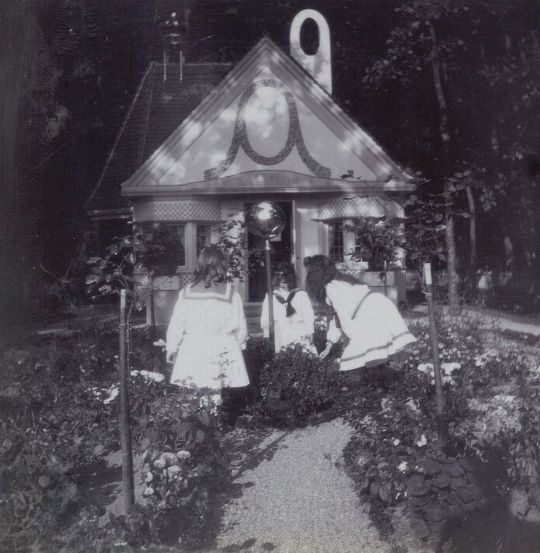

When she died in 1903, the playhouse wasn’t used anymore until her half brothers (Georg Donatus and Ludwig) started to play in it

(Photo from @princesselisabethofhesse. Go check out her account for more in-depth information on this subject!)
If you go visit Wolfsgarten today, you can find the playhouse sitting in the same spot as it was in 1902.

No one is allowed inside the house out of respect for its past visitors but there are photos of the inside.


Ella had immense fun in this little house and whenever you visit, you can know that you are standing in the same spot as Ella and her cousins and friends once did.

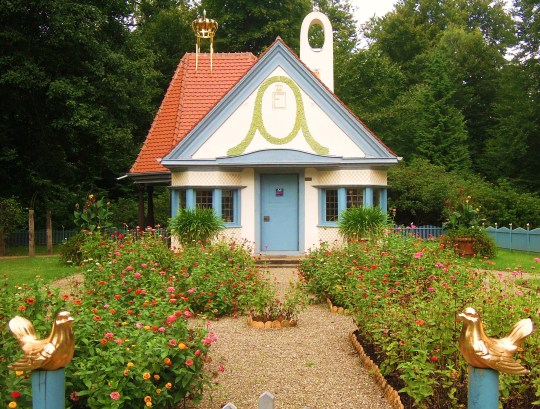
#princess elisabeth of hesse#otma#ella of hesse#ella’s playhouse#wolfsgarten#hesse#mine#elisabeth of hesse#ernst louis#early 1900s#1902#1903#prince georg donatus#prince ludwig#playhouse
19 notes
·
View notes
Photo

Princess and Landgravine Louise of Hesse-Darmstadt (30 January 1757 – 14 February 1830) was a German princess. She was the daughter of Louis IX, Landgrave of Hesse-Darmstadt. On 3 October 1775 she married duke (later grand-duke) Charles Augustus of Saxe-Weimar-Eisenach and as such a member of the court sphere of Weimar Classicism. She was held to be serious and introverted but also compassionate and sympathetic, in the aftermath of the Battle of Jena which guaranteed her part in the later "myth of Weimar" ("Weimarmythos").
#Louise of Hesse-Darmstadt#House Hesse-Darmstadt#XVIII century#XIX century#people#portrait#paintings#art#arte
8 notes
·
View notes
Text
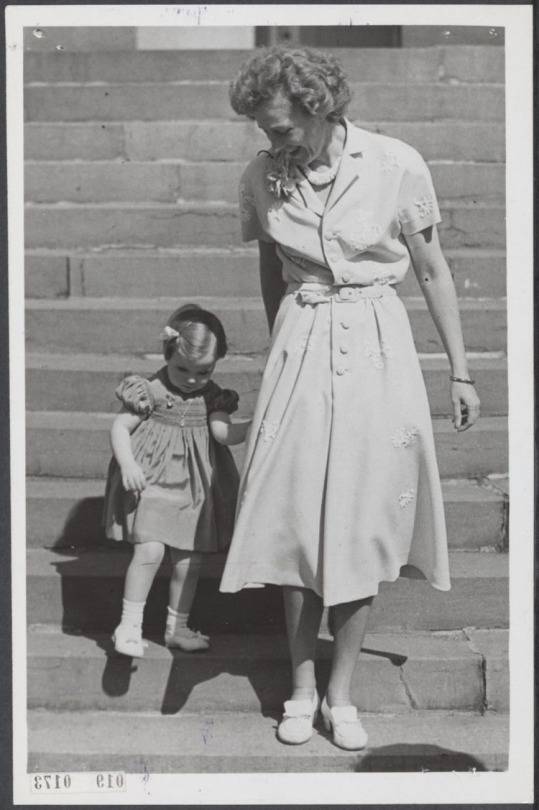
Margaret, Princess of Hesse and by Rhine with little Princess Johanna of Hesse and by Rhine 1939.
#Margaret Princess of Hesse and by Rhine#johanna of hesse and by rhine#hesse and by rhine#hessen#hesse family#hessian royal family#house of hesse#darmstadt
22 notes
·
View notes
Text
February 2023 Books
Death by Disguise by E. L. Bates
It was a pleasure to spend time with Maia and Len again! I enjoyed the Cambridge setting. The magical elements of the mystery were intriguing. And I'm curious to see where the new developments of the ending lead the characters, who are about to experience significant changes.
Freddy Goes to Florida, Freddy Goes to the North Pole, and Freddy the Detective by Walter R. Brooks
Frequently humorous, but I don't think I would read this series three at a time again (which is not the books' fault).
A Box of Bones, The Inn Between, and The Doll's Eye by Marina Cohen
A Box of Bones was my favorite of these (dare I say I liked it a little better than the also very good Small Spaces?)--readable blend of characterization and atmospheric creepiness. Also major points for the Lake Champlain setting and the mentions of the small town where I was born! It plays a small but significant role in the story.
The Inn Between was effectively creepy. I'm not sure how I feel about the ending, which leaves the protagonist in a place where ideally she shouldn't be, but yet the wording subtly implies this could change?
The Doll's Eye had an absolutely horrifying ending. Yikes. It was well-written but yikes.
She, the Adventuress by Dorothy Crayder (reread)
I acquired a copy of this one a while back and wanted to revisit it.
The Princess Aline by Richard Harding Davis
This one has an interesting history. The fictional Princess Aline was inspired by Princess Alix of Hesse-Darmstadt (the future Tsarina Alexandra of Russia), whom Davis was apparently infatuated with after having seen her once from a distance. Reportedly Alix's grandmother Queen Victoria and her daughters read and enjoyed Davis's book. Charles Dana Gibson's illustrations of Aline bear a resemblance to Alix too.
I liked the concept of this one better than the execution. An artist with rather shallow views on women becomes infatuated with a princess and follows her across Europe, only to gradually come to terms with the fact that she is unattainable and that he has actually fallen in love with a young woman he has been traveling with. I didn't care much for the protagonist, so it was difficult for me to get invested in anything he was doing, and the clarity at the end came maybe a bit too late to convince me.
The Tiger Rising by Kate DiCamillo (reread)
Goodreads tells me I read this in 2011. I have no memory of it from then but liked it this time.
The Finches' Fabulous Furnace by Roger Wolcott Drury
A family moves into a house with a very small but potentially dangerous volcano in the basement. I was initially frustrated with Mr. Finch's approach to the situation; at first only he, his son, and the man who sold them the house know about the volcano, and Mr. Finch chooses to conceal this information from his wife and daughter on the grounds that it might worry them. The volcano affects significant things like the temperature of the house, and Mrs. Finch is naturally concerned, but her husband makes no effort to set straight her assumption that they have an unusual furnace. He and his son tie themselves in knots trying to conceal the problem rather than putting the problem out in the open and dealing with it. When Mrs. Finch and her daughter do find out, they have very realistic concerns, which the guys dismiss, and the daughter in particular wants to let the entire town know what potential danger they're in. By then, some important (male) figures in the town know too, and they also insist that the volcano be kept secret for the sake of appearances (heaven forbid a major town festival be compromised!). And it goes about as well as you would expect.
It seems to be a commentary on the importance of openly addressing problems with the people they concern rather than leaving people deceived/in the dark "for their own good." And that's a truth worth expressing.
Meet the Austins, The Moon by Night, and A Ring of Endless Light by Madeleine L'Engle (reread)
I didn't love A Ring of Endless Light as much this time as I did when I originally read (at what was just the right time--dealing with death was not so close to me this time around), but I do still like them, mostly for Vicky, who is very real and relatable in her struggles to figure out life. But I am begging this girl to, if she absolutely must date, date a boy who is a) her age and not a legal adult and b) not a condescending jerk. She repeatedly ends up with guys who are varying degrees of this.
If L'Engle absolutely had to keep bringing Zachary Gray back, I wish she would have just given him an effective, lasting redemption arc instead of handing character growth to him over and over on a silver platter and letting him reject it every. single. time. and keep on being The Worst.
The Boy in the Box by Cary Fagan
This was my Blind Date with a Book selection! I actually enjoyed it. The characters were engaging, and the world had that middle-grade-characteristic tone of being in reality (probably not magical) but just a little to the left in terms of bizarreness.
The Story That Cannot Be Told by J. Kasper Kramer
Middle-grade historical fiction set in Romania in 1989. I learned a lot about this aspect of history and enjoyed the narrative and its fascinating themes of the roles that stories take in a world full of surveillance and suppression and betrayals. Kramer weaves the young protagonist's retelling of a Romanian fairy tale in with the larger story to good effect.
And it had a happy ending! Stories in that sort of setting so frequently don't.
The Light Princess by George MacDonald
Enjoyable, in a Victorian fairy tale way.
The Faerie Door by B. E. Maxwell
Beautiful cover, and there was potential in the concept of a Victorian girl and a 1960s American boy having fantastical adventures together. Operative word being together, though. They got arbitrarily split up and the chapters alternated between each's seemingly unrelated adventure. Any chance for them to genuinely bond and affect each other's character development was gone, and the result seemed excessively long, derivative, and rather a slog to read, unfortunately.
The Little Princess of Tower Hill by L. T. Meade
What a difference over a century can make in how a story appears. I liked the protagonist, who wasn't really such a bad girl as the narrative seemed to think, and her male cousin, who is presented as a role model for her, comes across as condescending and obnoxious. There's a disabled girl from a poor family whom the narrative treats as only having worth when she can be of help/use/support to people with perfect health and/or more means. An interesting look at the rhetoric of children's stories of the time, but I can understand why this one hasn't been remembered.
Once on a Time by A. A. Milne
Very witty, as can be expected from Milne. The characters aren't always easy to like, but Milne does go out of his way to make them more than stock roles.
Along the Shore: Tales of the Sea by L. M. Montgomery
It was interesting to see some forerunners of characters and subplots from the Anne series (Montgomery was apparently straight up plagiarizing her own short stories sometimes).
Grounded: The Adventures of Rapunzel by Megan Morrison
Some of the action of this book dragged for me, but by the end it became a really interesting exploration of Rapunzel's relationship with the witch who exploited her. It's extremely difficult for this Rapunzel to accept the truth that she has been exploited by someone whom she considers a loving mother figure, and she spends a lot of the narrative making herself unpleasant and clinging to her delusions--they're all she has. Slowly, she has to accept the truth and figure out how to navigate the complicated feelings she has toward the witch. There's a surprising amount of nuance for a book on this age level, and I was intrigued enough by how this was handled to want to seek out the rest of the series.
The House of a Thousand Candles by Meredith Nicholson
There were some brilliant one-liners in this one. The Gothic-ish concept had potential. But the pacing didn't work for me, I couldn't warm up to the protagonist (what is it with the male leads from this era?), and it turned out to be much less of a page turner than I was expecting.
The Valley of Lost Secrets by Lesley Parr
Middle-grade historical fiction about evacuees in Wales during World War II--how two brother adjust to their new life and host family while getting caught up in some local mysteries, such as the identity of the human skull the elder brother finds hidden in a tree. (There are some similarities to the real-life unsolved case of "Bella in the wych elm," which I found fascinating.) Both readable and believable in its portrayal of the historical setting (which is of major importance to me in historical fiction). This author has a couple of other books, and I think I'll seek them out.
Salt to the Sea by Ruta Sepetys
Well, that was utterly devastating, but what else can one expect from Sepetys? I learned a lot about an event I had never heard of and am quite impressed by the amount of research that went into this writing. Sepetys's author's note provides additional background and even a bibliography.
Miss Buncle's Book by D. E. Stevenson
Loved the premise of this one. It seemed to drag or get redundant as it progressed, and I don't think I'll look for the other books, but some of the characters were delightful. I was reminded a bit of the Mapp and Lucia stories, if they had had a much less cynical worldview.
No significant comics this month, just bits of things here and there.
19 notes
·
View notes
Text
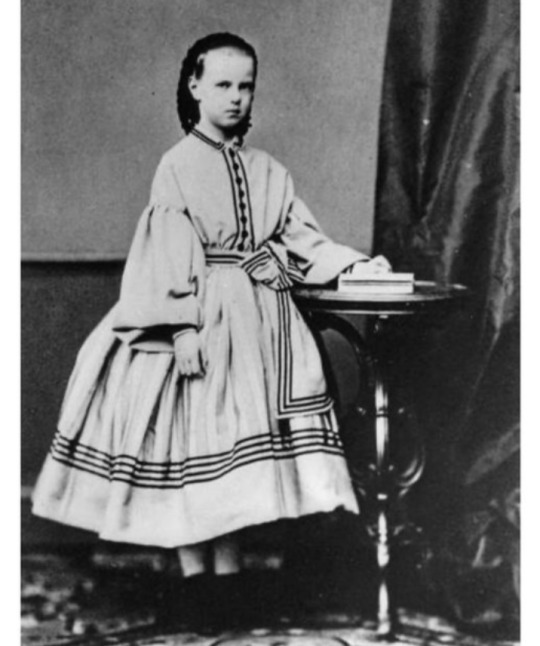

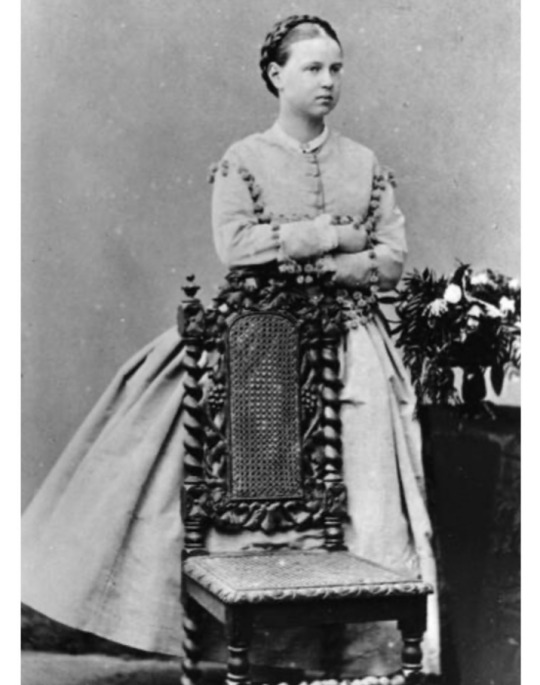
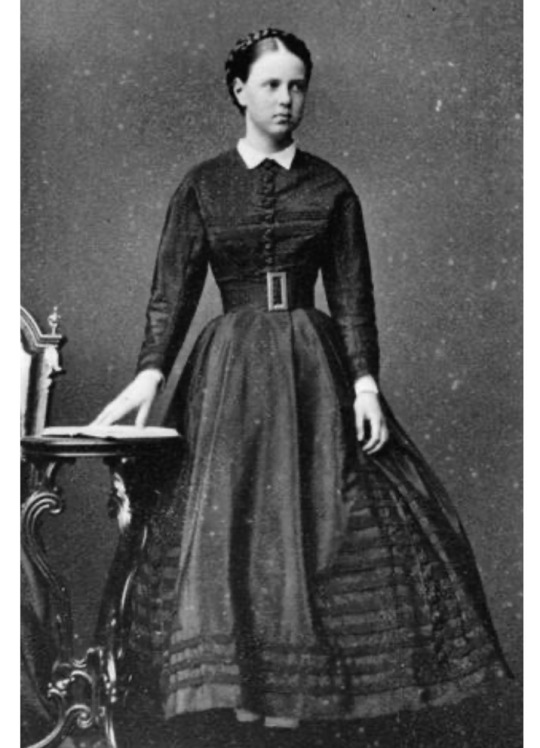





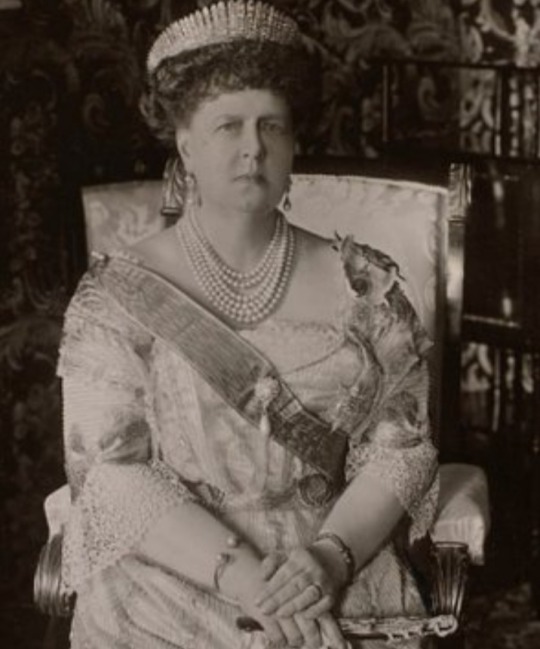
BORN ON THIS DAY:
Grand Duchess Maria Alexandrovna of Russia (17 October [O.S. 5 October] 1853 – 24 October 1920) was the fifth child and only surviving daughter of Alexander II of Russia and Marie of Hesse and by Rhine.
She was Duchess of Edinburgh and later Duchess of Saxe-Coburg and Gotha as the wife of Alfred, Duke of Saxe-Coburg and Gotha.
She was the younger sister of Alexander III of Russia and the paternal aunt of Russia's last emperor, Nicholas II.
#Grand Duchess Maria Alexandrovna of Russia#Alexander II of Russia#Marie of Hesse and by Rhine#Prince Alfred#Duke of Saxe-Coburg and Gotha#Alexander III of Russia#Nicholas II#House of Romanov#Hesse-Darmstadt#House of Hesse#House of Saxe-Coburg and Gotha
6 notes
·
View notes
Note
Was Prince Maurice of Battenburg a German soldier?
He was not! Maurice was a Lieutenant in the King's Royal Rifle Corps, part of the larger British Expeditionary Force.
But, he was fairly German. He was born at Balmoral Castle, in Scotland - the son of Princess Beatrice (Queen Victoria's youngest daughter/child) and Prince Henry of Battenburg, an Austrian-born lower-level member of the grand House of Hesse-Darmstadt, who were ethnically German/Austrian. But all four of their children were raised and educated in England under the close attention of their Grandmother, Queen V.
In 1917, anti-German sentiments were high, and the Royal family (and others) dropped their German titles and anglicized their names. The Royal name went from the German House of Saxe-Coburg and Gotha, and the Battenburg's became Mountbatten, which you may recognize from the surname of the late Prince Philip, whose mother Alice was Prince Maurice's first cousin. Since Maurice died so early in the war, 1914, he died before many of his family members changed their surname, and so he's buried as Battenburg- but his siblings later changed to Mountbatten.
#ask me anything#ask#history#royal fanily#British Royal Family#the great war#world war one#ww1#historical photos#the first world war#wwi#1917#world war 1#prince charles#british royalty#royal family
2 notes
·
View notes
Text

The Rock Crystal Egg or Revolving Miniatures Egg is an Imperial Fabergé egg, one in a series of fifty-two jeweled eggs made under the supervision of Peter Carl Fabergé for the Russian Imperial family. It was created in 1896 for Empress Alexandra Fyodorovna. The egg currently resides in the Virginia Museum of Fine Arts.The egg was created by Faberge's workmaster, Mikhail Evlampievich Perkhin (Russian, 1860–1903) with miniatures by Johannes Zehngraf (Danish, 1857–1908)[2] It stands about 248 mm (9 3/4 in) tall on its stand, with a diameter of 98 mm (3 7/8 in.)[3] The outer shell is rock crystal banded with emerald-green enameled gold studded with diamonds. On the apex of the egg is a 27-carat (5.4 g) Siberian emerald supported by an emerald-green enameled gold mount. This cabochon-style emerald is one of the largest gemstones Fabergé used in any of the Imperial eggs.[4] The egg's base sits on a plinth of rock crystal. The base consists of a colorfully enameled gold double spheroid which is circled twice with rose-cut diamonds. It has the monograms of the Tsarina, as the Princess Alix of Hesse-Darmstadt before her marriage, and later as Alexandra Fedorovna, Empress of Russia. Each monogram is surmounted with a diamond crown of the respective royal house.[4] These monograms form a continuous pattern around the base of the egg.Inside the rock crystal egg is a gold support holding twelve miniature paintings. The paintings are of the various palaces and residences that were significant to the Empress. Each location holds a special memory for Nicholas and Alexandra in the early days of their courtship, as they had just been married two years prior, in 1894.
When the large cabochon emerald on the apex is depressed it engages a mechanism that rotates the miniatures inside the egg. A hook moves down and folds the framed pictures back, like the pages of a book, so two paintings can be fully seen at one time.[1] Each miniature is framed in gold with an emerald on the apex. The frames are attached to a central fluted gold shaft which passes vertically through the egg.[4]
The locations include:
The Neues Palais, Darmstadt, Germany: Palace where the Empress was born.
Kranichstein, Hesse: A favorite summer residence of the Empress' youth.
Balmoral Castle, Scotland: Childhood holiday destination of Alexandra's grandmother, Queen Victoria.
Old Grand Ducal Palace (Altes Palais), Darmstadt: Official seat of Alexandra's father, Ludwig IV, Grand Duke of Hesse.
Wolfsgarten, Hesse: Hunting lodge Alexandra's family visited as a child.
Windsor Castle, near London, England: A residence of Queen Victoria where Alexandra visited as a child.
Palace Church, Coburg: Site where Alexandra first consented to marry Nicholas.
Schloss Rosenau, Coburg: A site Nicholas and Alexandra visited the day after their engagement.
Osborne House, Isle of Wight: Site of Nicholas' visit to see Alexandra while they were engaged.
The Winter Palace, St. Petersburg: The site of Nicholas and Alexandra's wedding.
Anichkov Palace, St. Petersburg: Residence of Maria Feodorovna, where Alexandra spent her first year in Russia.
The Alexander Palace, Tsarskoe Selo, near St. Petersburg: the Imperial family's favorite winter residence.The egg was presented by Nicholas II to Alexandra Fedorovna on March 24, 1896. She received it at Eastertide in the same year that the young couple had suddenly ascended the throne.[1]
In 1909 the egg was housed in the Empress' study in the Winter Palace. The egg was seized by the Kerensky Provisional Government and moved to the Armory Palace of the Kremlin in Moscow along with approximately 40 other eggs. In 1930, the Rock Crystal Egg was one of the ten Eggs sold by the Antikvariat (Trade Department) to the Hammer Galleries in New York for 8000 rubles, or approximately $4000 U.S. In 1945 the egg became the last of five Imperial Easter Eggs bought by Lillian Thomas Pratt, the wife of a General Motors executive John Lee Pratt. Upon Lillian Thomas Pratt's death in 1947, the egg was willed to Virginia Museum of Fine Arts, Richmond, Virginia. It remains on view as part of the Virginia Museum of Fine Art's European Decorative Art collection
6 notes
·
View notes